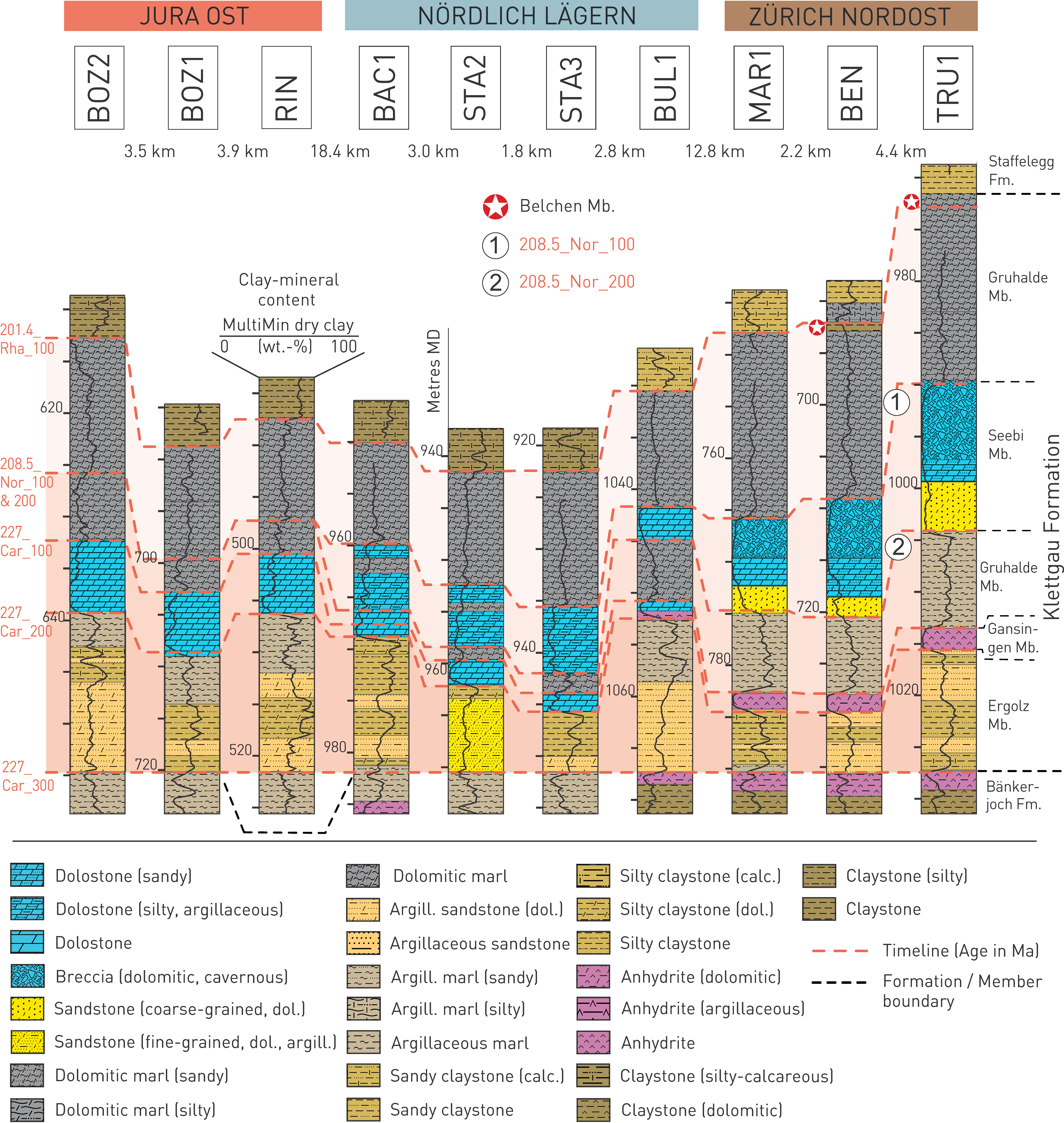The Klettgau Formation has a thickness varying between ca. 30 and 55 m (Fig. 4‑13). It is a heterogeneous succession dominated by dolomitic and argillaceous marls with intercalations of dolostones and partly porous sandstones (Fig. 4‑16). In some intervals this unit also includes porous dolomitic breccias and anhydrite. The Klettgau Formation can be divided into five members (Fig. 4‑14) in the three siting regions (Jordan et al. 2016b; Fig. 4‑16):
Ergolz Member (former «Schilfsandstein (sensu lato)» or «Schilfsandstein Formation», «Untere Bunte Mergel»): This member is the lowermost unit of the Klettgau Formation. Its thickness varies between ca. 6 and 21 m (Fig. 4‑17). It is dominated by dolomitic and argillaceous marl of the floodplain facies («normal facies»; Fig. 4‑16a). In this facies there are pedogenic nodular beds and nodules of dolostone. There are also partly porous sandstones and siltstones with cross- and flaser-bedding as well as ripples that were deposited in fluvial channels («channel facies»; Fig. 4‑16b, Fig. 4‑18, Fig. 4‑19). The sandstones of the Ergolz Member contain a significant proportion of lithic clasts, particularly up to ca. 30% of schistose clasts. As a transition between floodplain and channel facies deposits there are overbank facies deposits with a heterolithic association of fine, partly porous and silty sandstone and marl. Within the siting regions the most distinctive cross-bedded fluvial channel facies has been drilled in the STA2 borehole in western NL, but, based on its former depositional environment, it is likely that it also exists in all three siting regions. Channel-proximal overspill and overbank facies have been identified in boreholes of all three siting regions.
Gansingen Member (former «Gansinger Dolomit (sensu lato)»): The thickness of the overlying Gansingen Member generally decreases from west to east (JO: ca. 4.5 to 7 m, NL: ca. 1 to 3 m, ZNO: ca. 1.5 to 2 m; Fig. 4‑20). In JO, the Gansingen Member consists in the lower part of a dolostone locally with bivalves and ooids. This lower part is partly porous (up to cm-wide vugs and druses; and locally brecciated and fractured (Fig. 4‑16c). The upper part is mostly laminated, consisting of dolostone, dolomitic and argillaceous marl, locally with microbial mats, teepee structures and desiccation cracks. The NL siting region appears to lie in a transitional area between the depositional environments of JO and ZNO. In general, the facies is similar to JO, but thinner and with lower macroporosity. In the eastern boreholes of NL, the Gansingen Member includes an anhydritic facies at the base similar to ZNO, where it mostly consists of anhydrite (Fig. 4‑16d). In the lower part of the Gansingen Member of ZNO, interlayers of claystone and marl occur.
Gruhalde Member (former «Obere Bunte Mergel» and «Knollenmergel»): This unit is separated into a lower and upper part by the Seebi Member in NL and ZNO (Fig. 4‑15). In JO the Seebi Member does not occur or is thinner than one metre (Riniken borehole, RIN). The Gruhalde Member in JO has a thickness of ca. 14 to 19 m. The thickness of the lower part of the Gruhalde Member is up to ca. 6 m in NL and varies between ca. 7 to 10 m in ZNO. The thickness of the upper part varies between ca. 11 and 14 m in NL and ca. 16 and 18 m in ZNO. The Gruhalde Member mostly consists of variegated dolomitic marls («normal facies») with argillaceous marl and partly nodular pedogenic dolostone (argillaceous, partly silty to sandy; Fig. 4‑16g). Desiccation cracks, local brecciation, bioturbation and plant root tubes are typical phenomena for these deposits.
Seebi Member (former «Stubensandstein (sensu lato)»): The thickness generally increases from southwest to northeast (JO: not occurring or less < 1 m, NL: < 1 – ca. 6 m, ZNO: ca. 9 – 14 m; Fig. 4‑21). In NL it consists mostly of dolostone (partly argillaceous), partly brecciated sandy dolostone, argillaceous marl and few interlayers of dolomitic sandstone. The dolostone is partly brecciated. In ZNO, the Seebi Member consists of three parts. In the lower part, argillaceous, dolomitic and partly porous sandstone with interbedded dolostone prevails (Fig. 4‑16e). In the middle part, fine-grained dolostone, partly brecciated, is found. In the upper part, dolomitic breccia or dolocrete dominate with partly significant porosity and with vugs up to 10 cm (Fig. 4‑16f). The occurrence of brecciated dolocretes with elevated macroporosity seems to increase within ZNO from west to east (Fig. 4‑15).
Belchen Member (former «Rhät»): It occurs in the deep boreholes within the siting regions only in Benken (BEN) and TRU1 with a thickness of 0.6 and 1.4 m respectively. It consists mostly of partly bituminous and fossiliferous (thin bone beds) claystone.

Fig. 4‑15:Stratigraphic borehole correlation of the Klettgau Formation
For lithological nomenclature refer to Naef et al. (2019). Clay-mineral content after Becker & Marnat (2024). Some of the boundaries and lithologies as discussed in the original reports were adjusted to integrate all presented borehole data.

